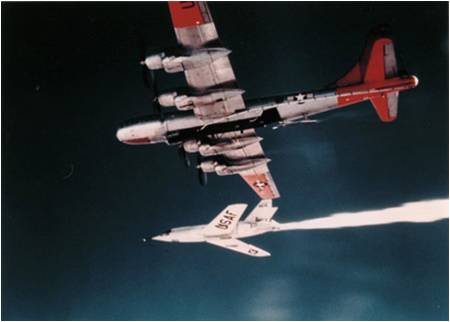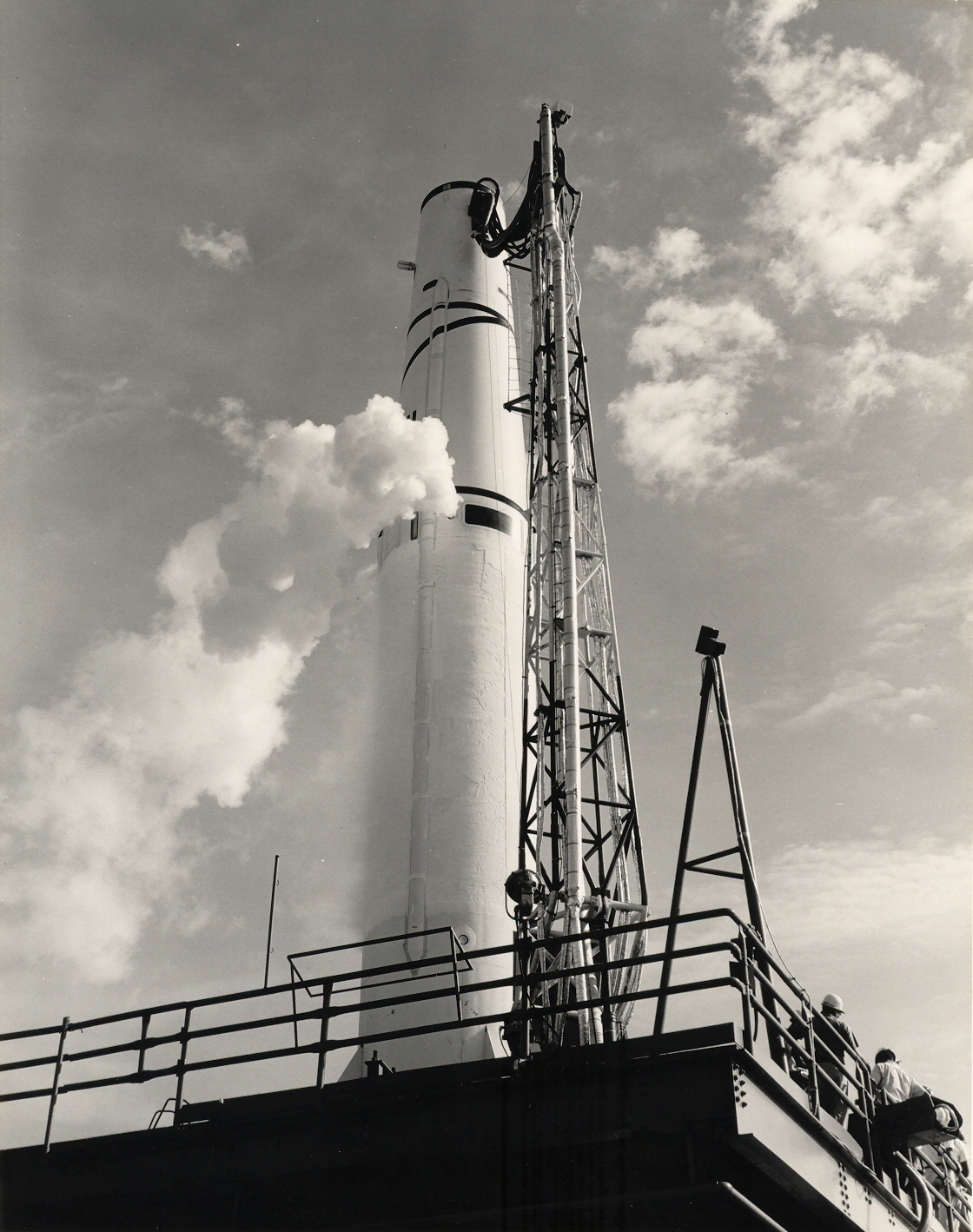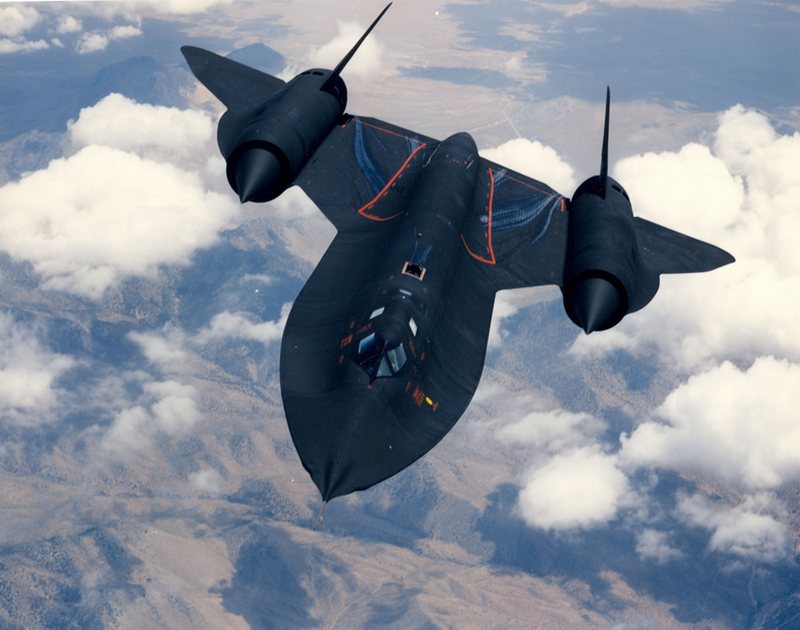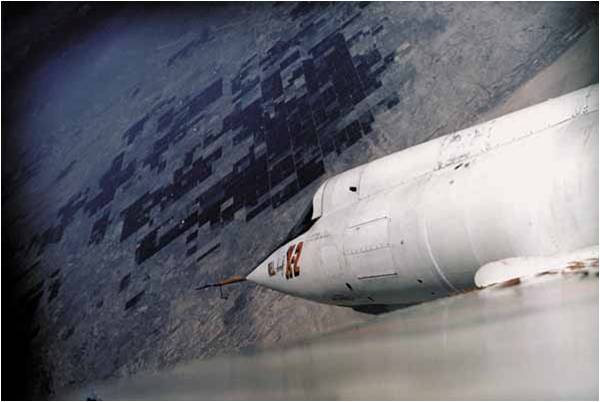
Fifty-three years ago this month, the Bell X-2 rocket-powered research aircraft reached a record speed of 2,094 mph with USAF Captain Milburn G. “Mel” Apt at the controls. This corresponded to a Mach number of 3.2 at 65,000 feet.
Mel Apt’s historic achievement came about because of the Air Force’s desire to have the X-2 reach Mach 3 before turning it over to the National Advisory Committee For Aeronautics (NACA) for further flight research testing. Just 20 days prior to Apt’s flight in the X-2, USAF Captain Iven C. Kincheloe, Jr. had flown the aircraft to a record altitude of 126,200 feet.
On Thursday, 27 September 1956, Apt and the last X-2 aircraft (S/N 46-674) dropped away from the USAF B-50 motherhip at 30,000 feet and 225 mph. Despite the fact that Apt had never flown an X-aircraft, he executed the flight profile exactly as briefed. In addition, the X-2’s twin-chamber XLR-25 rocket motor burned propellant 12.5 seconds longer than planned. Both of these factors contributed to the aircraft attaining a speed in excess of 2,000 mph.
Based on previous flight tests as well as flight simulator sessions, Apt knew that the X-2 had to slow to roughly Mach 2.4 before turning the aircraft back to Edwards. This was due to degraded directional stability, control reversal, and aerodynamic coupling issues that adversely affected the X-2 at higher Mach numbers.
However, Mel Apt was now faced with a difficult decision. If he waited for the X-2 to slow to Mach 2.4 before initiating a turn back to Edwards Air Force Base, he quite likely would not have enough energy and therefore range to reach Rogers Dry Lake. On the other hand, if he decided to initiate the turn back to Edwards at high Mach number, he risked having the X-2 depart controlled flight. Apt opted for the latter.
As Apt increased the aircraft’s angle-of-attack, the X-2 careened out of control and subjected him to a brutal pounding. Aircraft lateral acceleration varied between +6 and -6 g’s. The battered pilot ultimately found himself in a subsonic, inverted spin at 40,000 feet. At this point, Apt effected pyrotechnic separation of the X-2’s forebody which contained the cockpit and a drogue parachute.
X-2 forebody separation was clean and the drogue parachute deployed properly. However, Apt still needed to bail out of the X-2’s forebody and deploy his personal parachute to complete the emergency egress process. But, it was not to be. Mel Apt ran out of time, altitude, and luck. He lost his life when the X-2 forebody that he was trying to escape from impacted the ground at several hundred miles an hour.
Mel Apt’s flight to Mach 3.2 established a record that stood until the X-15 exceeded it in August 1960. However, the price for doing so was very high. The USAF lost a brave test pilot and the lone remaining X-2 on that fateful day in September 1956. The mishap also ended the USAF X-2 Program. NACA never did conduct flight research with the X-2.
However, for a few terrifying moments, Mel Apt was the fastest man alive.

Fifty-two years ago this month, the United States successfully tested a USAF/Douglas Thor missile for the first time. Thor Vehicle 105, launched from Launch Complex 17 at Cape Canaveral, flew 1,100 miles down the Eastern Test Range (ETR) on Saturday, 21 September 1957.
Named after the Norse god of thunder, the Thor (PGM-17A) was designed as a nuclear-armed Intermediate Range Ballistic Missle (IRBM). Operational Thor missiles were armed with a single W49 nuclear warhead having an explosive yield equivalent to 1.44 megatons of TNT.
The Thor measured 65 feet in length and had a maximum diameter of 8 feet. Weighing 110,000 pounds at lift-off, the test vehicle climbed-out on 150,000 pounds of thrust generated by its single Rocketdyne LR79-NA-9 first stage rocket motor. The powerplant used LOX/Kerosene propellants and had a nominal burn time of 165 seconds. Specific impulse was around 280 seconds.
Following development flight testing, the Thor would become the first operational ballistic missile deployed by the United States. Sixty Thor missiles were tended by twenty RAF missile squadrons scattered throughout the United Kingdom from 1958 through 1963.
Although its tour of duty was brief, the Thor served as an effective deterent to Soviet agression until the arrival of the first true Intercontinental Ballistic Missiles (ICBM). Interestingly, the Thor IRBM would become the basis for the first Delta launch vehicles, descendants of which remain in active service up to the current day.

Thirty-five years ago this month, the legendary USAF/Lockheed SR-71A Blackbird triple-sonic aircraft established an official world speed record as it traversed the 5,446.87 statute miles between London and Los Angeles in 3 hours 47 minutes and 39 seconds. Average speed was 1,435.59 mph.
The all-USAF crew of Captain Harold B. Adams (Pilot) and Major William C. Machorek (RSO) flew the historic mission in aircraft S/N 61-17972 on Friday, 13 September 1974. In their rapid east-to-west journey, the record-setting aircraft and its crew crossed 7 separate time zones.
To gain an added appreciation for the Blackbird’s impressive performance, one might consider the following. The Earth rotates through an arc distance of a little over 1,000 miles in one hour. The Blackbird averaged over 1,400 miles arc distance in one hour. In that sense, the aircraft out-raced the sun as it flew more than one-fifth the total distance around the globe.
Fittingly, the crew of Adams and Machorek received the FAI’s prestigous De La Vaulx medal in honor of their London-to-Los Angeles world speed record which stands to this very day.

Fifty-three years ago today, the USAF/Bell X-2 research aircraft flew to an altitude of 126,200 feet. This accomplishment took place on the penultimate mission of the type’s 20-flight aeronautical research program. The date was Friday, 07 September 1956.
The X-2 was the successor to Bell’s X-1A rocket-powered aircraft which had recorded maximum speed and altitude marks of 1,650 mph (Mach 2.44) and 90,440 feet, respectively. The X-2 was designed to fly beyond Mach 3 and above 100,000 feet. The X-2’s primary mission was to investigate aircraft flight control and aerodynamic heating in the triple-sonic flight regime.
The X-2 had a gross take-off weight of 24,910 lbs and was powered by a Curtis-Wright XLR-25 rocket motor which generated 15,000-lbs of thrust. Aircraft empty weight was 12,375 lbs. Like the majority of X-aircraft, the X-2 was air-launched from a mothership. In the X-2’s case, an USAF EB-50D served as the drop aircraft. The X-2 was released from the launch aircraft at 225 mph and 30,000 feet.
The pilot for the X-2 maximum altitude mission was USAF Captain Iven Carl Kincheloe, Jr. Kicheloe was a Korean War veteran and highly accomplished test pilot. He wore a partial pressure suit for survival at extreme altitude.
While the dynamic pressure at the apex of his trajectory was only 19 psf, Kincheloe successfully piloted the X-2 with aerodynamic controls only. The X-2 did not have reaction controls. Mach number over the top was supersonic (approximately Mach 1.7).
Kicheloe’s maximum altitude flight in the X-2 (S/N 46-674) would remain the highest altitude achieved by a manned aircraft until August of 1960 when the fabled X-15 would fly just beyond 136,000 feet. However, for his achievement on this late summer day in 1956, the popular press would refer to Iven Kicheloe as the “First of the Space Men”.





